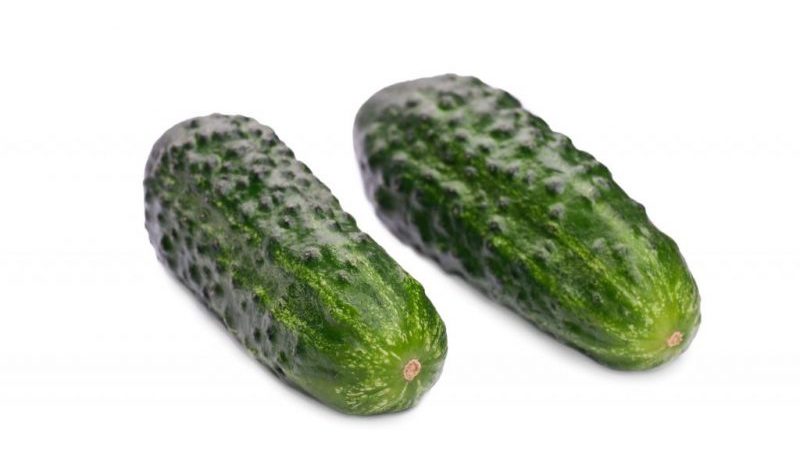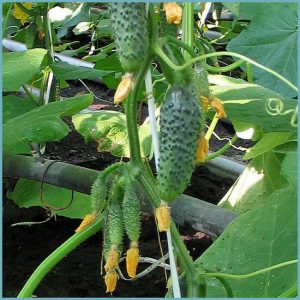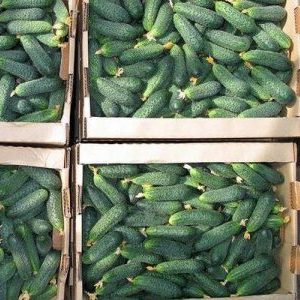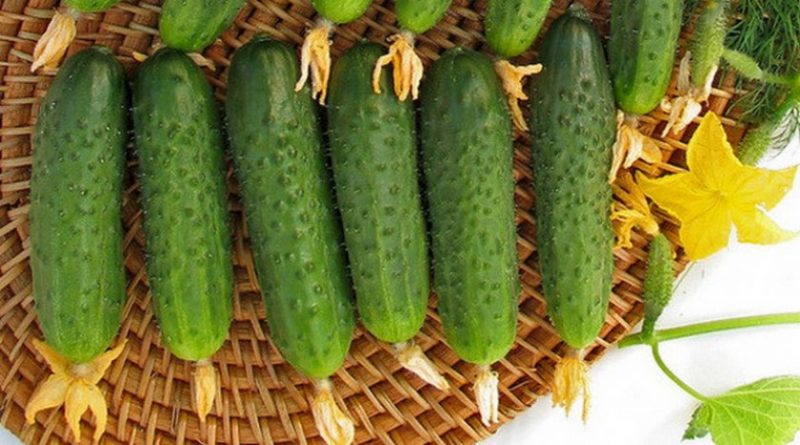The early ripening hybrid of Maryina Roscha f1 cucumber, loved by summer residents for its high yield
Cucumber hybrid Maryina Roshcha F1 has the qualities that gardeners look for in plants for planting on plots. Due to its pleasant taste and a large number of fruits on the bush, it has been especially popular for several years.
From the article you will find out what cucumbers are, how other gardeners liked them and how to grow them correctly.
The content of the article
Description of the hybrid
An early ripe hybrid of the parthenocarpic type Maryina Roshcha has established itself as reliable and giving stable yields... Due to self-pollination and predominantly female type of flowering, the hybrid is highly productive.
With proper and high-quality care, the bundle formation of ovaries allows you to get 9-12 kg of crispy greens per square meter. Some experienced summer residents achieve such results from one bush. This is due to the fact that the plant is not afraid of cold weather and can bear fruit even in the shade up to frost.

Distinctive features
The hybrid has the following qualities:
- cold resistance;
- shade tolerance;
- massive formation of lashes and shoots;
- unpretentiousness.
It is not surprising that Maryina Roshcha gives a high yield regardless of the weather and the region of cultivation, justifying its name. Up to twelve fruits can ripen on one plant at a time.
Composition and properties
Cucumber, as a low-calorie product, can be consumed with almost any diet. It is low in carbohydrates, fats and proteins. Due to the fact that it is almost 100% water, cucumber perfectly cleanses the body and helps to improve digestion.
Dietary fiber, minerals (Ca, Na, Fe, P, Zn, Mg and others) and vitamins contained in cucumbers have a beneficial effect on the intestines, strengthen the heart and cleanse the kidneys. This is why eating fresh cucumbers is so beneficial, especially during the summer season.
Specifications
A cucumber bush is an almost three-meter liana with powerful lateral shoots with a moderate amount of foliage and a bundle of ovary formation. About four to five pupae are formed in each bundle. Cucumbers grow on average up to ten or twelve centimeters.
Fruits with white thorns and light tubercles are characterized by a rich green color and strong taste and marketability. Juicy, dense, without bitterness, fruits weighing about 100 g are ideal for salads, slices, pickling and pickling. They retain their properties for about three months.
Due to the early maturity of the hybrid in warm regions, two or more crops per season are obtained up to 12 kg per square meter.
How to grow yourself
Let us consider in detail the features of growing cucumbers at Maryina Roshcha.
Planting by seed and seedling method
Traditionally, when growing cucumbers, seed and seedling methods are used. The fruits ripen 40-45 days after planting. Depending on when you want to get them, the seeds can be planted directly in the ground or grown through seedlings using biodegradable peat cups or pots.
In them, seeds are planted to a depth of 1-1.5 cm, which, as gardeners note, give 100% germination. Maryina Roshcha grows well on the windowsill. When the threat of the return of frost goes away, the plants are planted in a permanent place in open ground or a greenhouse. Peat cups, decomposing, serve as fertilizer.
The seed method involves planting cucumbers immediately in a permanent place. It is suitable for regions with warm climates. In the northern regions, it is worth choosing the cultivation of cucumbers through seedlings.

Let us consider in more detail the technology of seed planting of cucumbers. In a well-prepared and fertilized soil, seeds are sown that have been treated and pre-selected. The harvest largely depends on the choice of the site. It is known that cucumbers love to bear fruit in well-lit sunny beds. Maryina Roshcha is less whimsical to the conditions and will delight with fruits even in a shaded place.
Seeds of Maryina Roshcha are distinguished by good germination. This avoids traditional soaking and germination prior to sowing. It is enough to dig up and fertilize the bed, carefully level the surface, remove the lumps and evenly plant the seed.
Next, you should water well and prepare the shelter for the first time to avoid rapid evaporation of moisture and drying out of the soil. Otherwise, the seeds will not germinate. After planting, the soil is mulched and loosened.
Growing and care
For seedlings, seeds of Maryina Roshcha cucumbers are sown at the end of March. To a permanent place - in April - mid-May. Planting dates depend on climatic and weather conditions. Given the dislike of the cucumber culture for transplants, you can wait until warm weather sets in and immediately plant the seeds in the ground or greenhouse.
The greenhouse option allows you to get an earlier and more abundant harvest, protects plants from bad weather and many diseases. In open ground, three or four roots are placed on one square meter, in greenhouses - two or three. The plant is unpretentious and therefore does not need additional care, except for tying bushes.
Reference. During the growing season, you can feed the seedlings with mineral fertilizers.
Features of cultivation and possible difficulties
For a hybrid, loam and sandy loam soil are optimal. Care should be taken to ensure that there is no stagnation of moisture, and periodically loosen the soil to saturate with oxygen. The proven peat and some minerals can be used as fertilizer.
When growing Maryina Roscha, it is recommended to use trellises and pinch the plants at a height of about two meters... This will allow you to use the space wisely and form a beautiful plant with a large number of ovaries and fruits.
Diseases and pests
One of the features of the hybrid is resistance to a number of diseases. It is not afraid of powdery mildew, olive spot, cucumber mosaic virus and root rot that infect cucumber crops. This allows you to maintain a consistently high yield. Medium resistance to a number of diseases makes plant maintenance easier.
Cucumbers are most harmful aphid, whitefly, ants and spider mites.
If pests appear on the bushes, they are collected mechanically or treated with insecticides ("Taboo", "Regent").
Less radical folk methods also help in pest control, for example, tobacco dust, garlic infusion, wormwood. Tobacco dust and ash in equal proportions have proven themselves in the fight against aphids and black flea beetles.
Diseased plants should be treated in the morning, while the cucumbers are in dew. To moist greenery adheres harmful to pests tobacco-ash dust, which is safe for cucumbers and humans. At the end of the season, prevention should be carried out.
Harvesting and application of the crop

Harvesting begins one and a half months after sowing and continues until late autumn. Practically from the beginning of June to October every two or three days you can feast on fresh cucumbers. They should be collected as they ripen in the evening, avoiding overgrowth. Neat, even fruits are good for salting and pickling.
Excellent keeping quality and transportability allow summer residents to make money on cucumbers.Beautiful fruits that can be easily transported over long distances are always in demand with the buyer.
Advantages and disadvantages
Maryina Roshcha has much more advantages than disadvantages. This is what does hybrid in demand among summer residents. He was loved for:
- yield;
- keeping quality;
- disease resistance;
- unpretentious care;
- great taste.
The hybrid has practically no negative reviews. Both professionals and amateurs praise Maryina Roscha for the friendly return of the harvest.
Reviews

About the cucumber hybrid Maryina Roshcha, gardeners leave various reviews, mostly positive.
Valentina, Tula: “I planted three-week old seedlings from Maryina Grove in a greenhouse. I was afraid to go straight to the ground, because the spring was cold. It turned out she did the right thing. At the beginning of June, we already tasted the first cucumbers. Delicious, crispy, enjoyed by the whole family. A bountiful harvest came out in the greenhouse. A good result was given by watering with warm water and feeding once a month with mineral fertilizers. I liked the early maturity and abundant ripening of the fruits. Well, it is pleasant to the eye to look at a beautiful liana covered with cucumbers. They lie for a long time, they are good in salting. There is no emptiness or bitter taste like some varieties. "
Anna, Kemerovo: “A neighbor advised me to plant Maryina Grove. I decided to try it and it was right. I planted it in May, when the weather was warm, right into the ground. After a month and a half, they ate cucumbers with might and main. I didn't fertilize with anything else. Despite this, the plants did not get sick and gave a good harvest. I liked the cucumbers to taste, although the skin seemed a little harsh. This is probably why cucumbers lie for so long and do not spoil. The hybrid seemed to me ideal for salting... Smooth, beautiful cucumbers, as in the photo, and ask to be in the banks. "
Conclusion
The early ripening hybrid of Maryina Roscha cucumbers is a real find for summer residents. A high-yielding, unpretentious culture, resistant to pests and diseases, will provide the whole family with useful trace elements and vitamins in the summer season and delight with gherkins in the winter in the form of pickles and marinades.